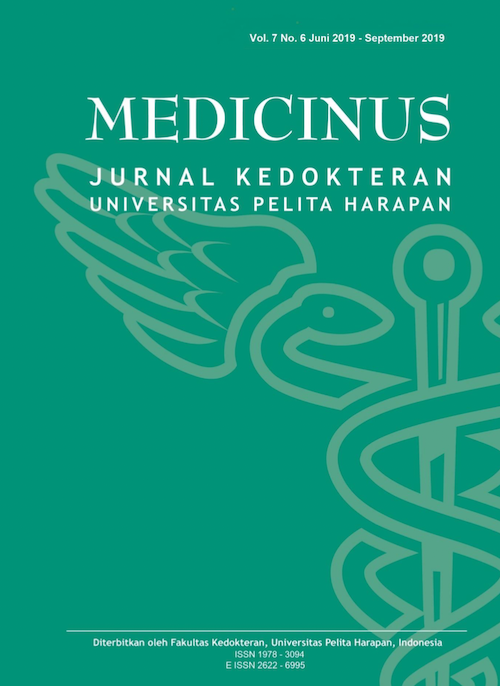How Much Depressed are Lung Tuberculosis Patients in Tangerang, Banten Province, Indonesia?
DOI:
https://doi.org/10.19166/med.v7i6.2597Keywords:
Tuberculosis, patient depression, Lung diseaseAbstract
Introduction : Tuberculosis is an infectious disease caused by Mycobacterium Tuberculosis (MTB) and mostly attacks the lung and other organs. In patients with pulmonary tuberculosis, depression can occur and the factors that can cause it are age, sex, marital status, level of education, emplyment, long suffering from pulmonary tuberculosis and comorbidities. The purpose of this study is to show the prevalence and also degree of depression in patients with lung Tuberculosis in Tangerang, Banten Province, Indonesia.
Methods : The study design is cross sectional by asking participants to fill Zung Self-Rating Depression Scale that have been translated to Indonesian language. Participants were 129 patients with lung tuberculosis in Siloam General Hospitals Lippo Karawaci, Puskesmas Kutai and Puskesmas Curug.
Results : Mean age of the 137 patients with lung tuberculosis is 47.73 + 8.50 years old, and the mean of their height and weight are 163.94+ 7.59 centimeters and 51.10 + 7.40 kilograms. More than a half of the patients are male (69%), almost a half of the patients are low educated (48%) and almost all of the patients have been married (93.8%). More than a half of the lung tuberculosis patients experience deppression (70,5%). Approximately a half of the lung tuberculosis patients are having mild depression (50.4%). There is 1 patient is having severe depression (0.8%).
Conclusion : Degree of depression in adult patients suffer from lung Tuberculosis in Tangerang, Banten Province, Indonesia is high. More than a half of adult lung Tuberculosis patients are having depression. Depression is one of problems that should be concerned and also treated in patients with lung tuberculosis. Psychiatrist involvement in managing patients with lung tuberculosis is needed.
References
1. World Health Organization. Global tuberculosis report 2017. 2017.
2. Kementrian Kesehatan Republik Indonesia. Profil Kesehatan Indonesia Tahun 2015. 2016
3. Janmeja AK, Das SK, Bhargava R, Chavan BS. Psychotherapy Improves Compliance with Tuberculosis Treatment. Respiration. 2005; 72(4):375-80. https://doi.org/10.1159/000086251
4. Patchi A, Bratis D, Moussas G, Tselebis A. Psychiatric Morbidity and Other Factors Affecting Treatment Adherence in Pulmonary Tuberculosis Patients. Tuberculosis Research and Treatment. 2013:1-37. https://doi.org/10.1155/2013/489865
5. Sweetland A, Oquendo M, Wickmaratne P, Weissman M, Wainberg M. Depression: A silent driver of the global tuberculosis epidemic. World Psychiatry. 2014; 13(3):325-6. https://doi.org/10.1002/wps.20134
6. Koyanagi A, Vancampfort D, Cavalho AF. Depression comorbid with tuberculosis and its impact on health status: Cross-sectional analysis of community-based data from 48 low- and middle-income countries. BMC Med. 2017; 15:209. https://doi.org/10.1186/s12916-017-0975-5
7. Nahda ND, Kholis FN, Wardani ND. Faktor-faktor yang berpebgaruh terhadap kejadian depresi pada pasien tuberkulosis di RSUP DR. Kardiadi Semarang. Jurnal Kedokteran Dipenogoro. 2017; 6:4.
8. Amreen, Rizvi N. Frequency of Depression and Anxiety among Tuberculosis Patients. Journal of Tuberculosis Research. 2016; 4:4. https://doi.org/10.4236/jtr.2016.44021
9. Vega P, Sweetland A, Acha J, Castillo H, Guerra D, Fawzi S, et al. Psychiatric issues in the management of patients with multidrug-resistant tuberculosis. International Journal of Tuberculosis and Lung Disease. 2004; 8(6):749-759.
Downloads
Published
How to Cite
Issue
Section
License
Copyright (c) 2020 Tirta Darmawan, engelberta Pardamean, Vinsensa Anabella, Mark Mark, Amelia Gianina Widjaja

This work is licensed under a Creative Commons Attribution-ShareAlike 4.0 International License.
Authors who publish with this journal agree to the following terms:
1) Authors retain copyright and grant the journal right of first publication with the work simultaneously licensed under a Creative Commons Attribution License (CC-BY-SA 4.0) that allows others to share the work with an acknowledgement of the work's authorship and initial publication in this journal.
2) Authors are able to enter into separate, additional contractual arrangements for the non-exclusive distribution of the journal's published version of the work (e.g., post it to an institutional repository or publish it in a book), with an acknowledgement of its initial publication in this journal.
3) Authors are permitted and encouraged to post their work online (e.g., in institutional repositories or on their website). The final published PDF should be used and bibliographic details that credit the publication in this journal should be included.





